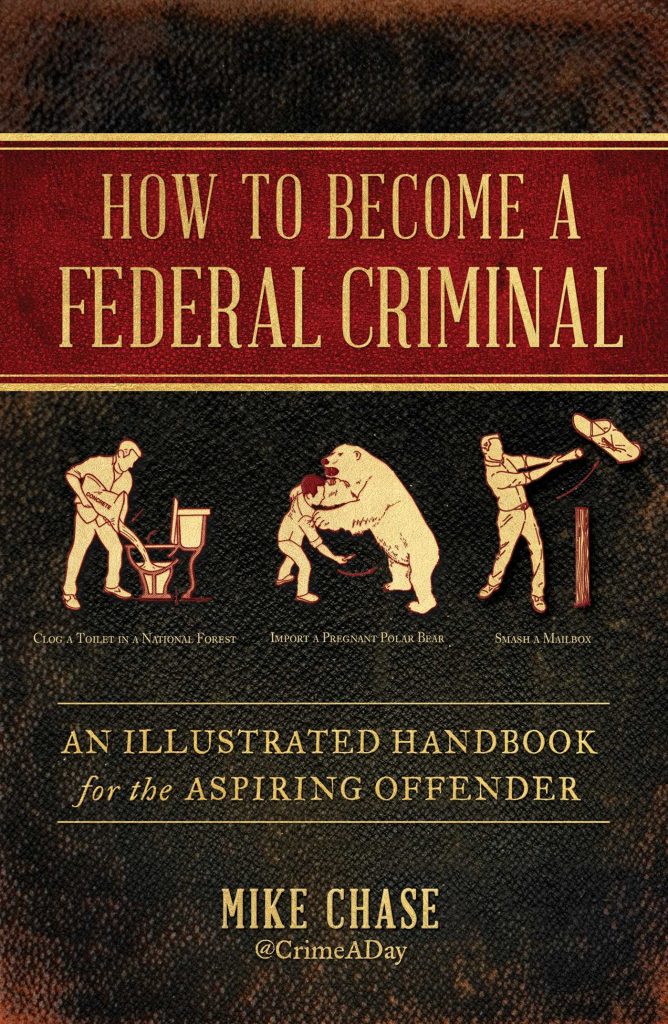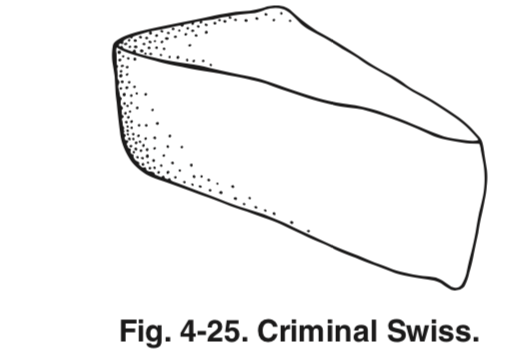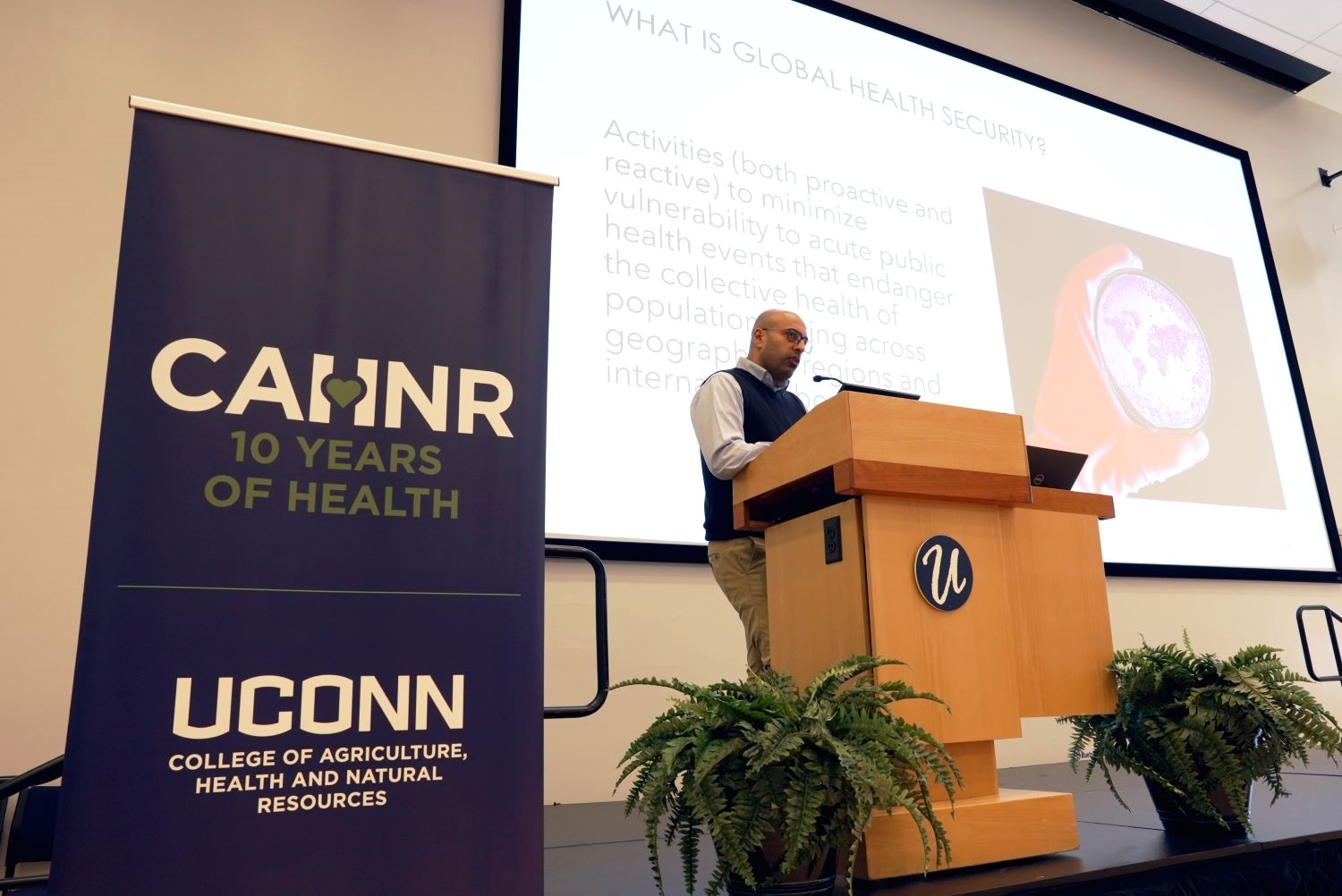Imagine doing hard time for wearing a Halloween costume, teasing an elk, or bringing too many pennies on a trip to Canada.
If these restrictions sound too ridiculous to be true, you are half-right: they are ridiculous, but the are not only true, they are enshrined in federal law, as one UConn School of Law alumnus has discovered, to the delight of a growing following online and in print.
Five years ago Mike Chase ’11 JD, a white collar criminal defense attorney in Hartford, started his own humorous exploration of crime and punishment with his anonymously written Twitter feed called “@CrimeADay,” sending out daily tweets about laws that could result in potentially harsh punishment for seemingly innocuous crimes, perhaps none more universally known than the warning on the tag affixed to a new mattress: “DO NOT REMOVE THIS TAG UNDER PENALTY OF LAW.”
With an increasingly loyal following online and his growing expertise in the history of the statutes, Chase decided to combine his growing file of laws, his humor, and his artistic skill in a book titled How to Become a Federal Criminal: An Illustrated Handbook for the Aspiring Offender, published this year by Simon and Schuster.
The book has received favorable reviews, including from The New York Times, which said: “Somebody with credentials has combed through a mountain of boring literature, highlighted all the ticklish parts and served them up for appreciation. This is an excellent book for people who like to start sentences with ‘Did you know that …’”
“The CrimeADay Twitter feed became an inextricable part of my identity,” Chase says about shedding his anonymity. “I had dug into these statues; the legislative history, the ‘why’ behind these laws of the statues, the prosecutions behind these laws. I really felt there was more important work behind it. That’s why I did the book and came out from the shadows.”

Although there is no precise calculation of how many federal statutes exist, Chase says the most cited number is approximately 300,000 laws, many that cover government agency regulations. The authority for innumerable federal crimes is rooted in the Constitution’s interstate commerce clause, aimed at focusing on activities that cross state lines, however the advance of technology – especially the internet — has almost eradicated purely state jurisdiction on many crimes, he notes. The real problem is that conviction on a federal charge results in criminal sanctions that stay on a person’s record.
“The criminal sanction is reserved for these extreme wrongs to society. When they allow that many things to be criminally punishable – the things that can make a person forever branded a criminal — they do need to be careful,” says Chase, noting that the majority of serious federal crimes involve fraud, guns, drugs and immigration violations. “But you still have 2% of the federal docket filled with these miscellaneous regulatory crimes, which means a couple thousand people a year still are getting criminal convictions for things you would never think of, like mislabeled fruit cocktail or clogging a toilet in a national forest.”
Among the examples of little-known laws Chase cites in his book:
HAM AND CHEESE SANDWICH: Two federal agencies – the Food and Drug Administration (FDA) and U.S. Department of Agriculture (USDA) have jurisdiction over the components in a ham and cheese sandwich. Bread falls under FDA and ham under USDA regulations. However, an open-faced sandwich is covered by USDA guidelines but another slice of bread moves it to FDA regulations.
MAIL CARRIER UNIFORMS: Originally a non-letter carrier could not wear a postal uniform under laws passed by Congress. Requests from actors to wear such uniforms were rejected up until 1967, when the law was changed to allow actors to wear the uniform “if the portrayal [did] not tend to discredit that service.” A similar law about portrayals of military personnel and uniforms was also on the books until a First Amendment case was settled at the Supreme Court of the United States that also eventually removed restrictions from postal uniforms. Still, only actors can wear postal uniforms and there are no Halloween costumes for mail carriers permitted.
COINS: Without a special license from the U.S. Mint, you cannot export pennies or nickels outside of the country. You can only travel with up to $5 in pennies or nickels, or up to $25 total in your pocket. Being found guilty gets you up to five years in prison.
BIRDS: While there are laws protecting migratory birds, but there are also population control regulations for Canada geese. However, it is a federal crime to shoot a Canada goose standing in a sailboat with the sails unfurled.
NATIONAL PARKS: Among the activities that could land you up to six months in jail if done in a National Park are scattering human ashes without a permit, teasing animals, hitchhiking, gambling and using drugs, poison, explosives or electricity to catch fish.
Chase continues to tweet daily from “@CrimeADay,” and says he enjoys providing fodder for discussion among the legal community and the public, even as he is busy working with clients and handling their cases. He thinks it is beneficial to identify issues from the perspective of a law practitioner.
“It’s really fun to have these conversations and break it out beyond a tweet. I think maintaining that foot in legal practice gives me enough perspective to know where the real issues are,” he says. “What I’m not doing in the book or with @CrimeADay is just saying the whole criminal justice system is a farce. What I am saying is let’s dissect the criminal justice system and figure out where the problems are and see if we can make a more equitable system. Sometimes I actually come across these statues in my practice, which is fascinating.”
Listen to an interview with Chase on UConn 360:



